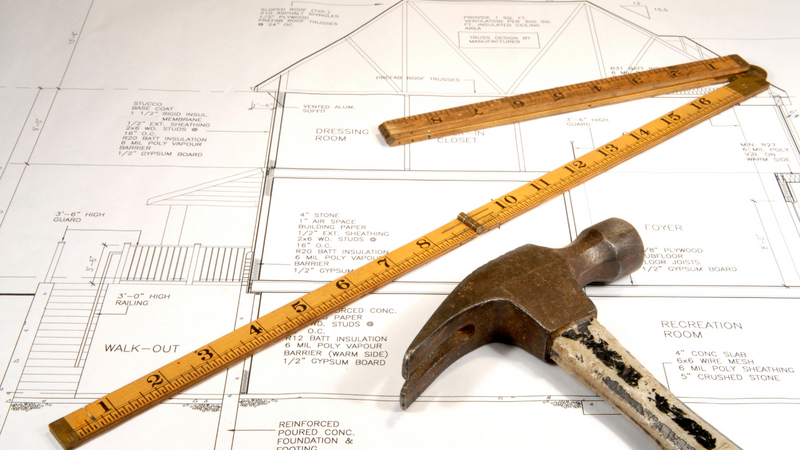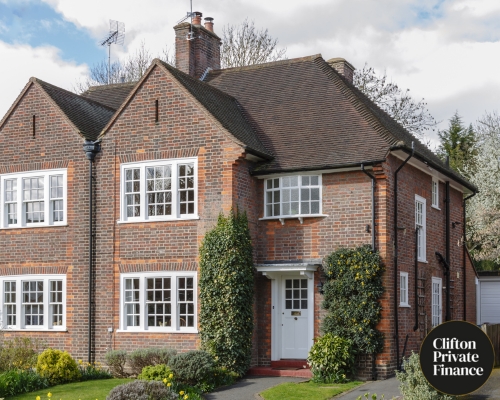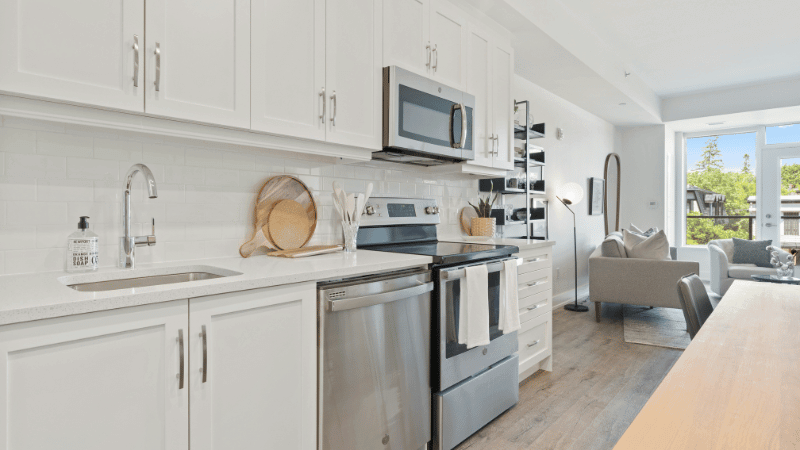Categories
How To Get A Renovation Mortgage

A renovation mortgage is designed to help property owners finance the cost of renovating or remodelling their property.
Whether you're a first-time buyer, a property developer, or anywhere in between, choosing the right finance for buying a renovation property is as important as choosing the design, a builder, or the materials, fixtures, and finishing touches.
When you find a property as a 'fixer-upper' with a view to either selling it on for a profit, letting it out, or remortgaging it to live in yourself, you'll need an appropriate finance package to help you see the project through.
Obtaining a conventional mortgage might not be an option, so you may need to get a renovation mortgage instead.
This guide explains everything you need to know about renovation mortgages, how they work, eligibility criteria, how to apply for one and how to find the best deal.

In This Guide:
What is a Renovation Mortgage?
If you’re buying a house that needs more than a quick lick of paint and perhaps a wall knocked through, you may not be able to use standard mortgage finance.
A renovation mortgage is a specialist type of loan that enables a borrower to obtain a loan equal to a property's post-renovation value. This gives the buyer the funds to purchase and cover the refurbishment costs. The extra finance taken out for refurbishment is paid off in monthly instalments alongside your mortgage.
Usually, lenders offer a renovation mortgage, with the funds released in instalments as the renovation work progresses. During the project, you may need to have your property inspected repeatedly, which involves extra fees. Depending on the mortgage type, you may be able to remortgage to a standard property loan once the home improvements are complete.
Is a Renovation Mortgage The Best Option?
A number of high street banks and building societies offer renovation mortgages, but the vast majority only consider loans for habitable properties, which can eliminate many of your renovation plans.
Most high street banks and lenders won’t give you a mortgage if…
- The property is derelict or in very poor condition
- The property is considered 'uninhabitable’, i.e., no kitchen, functioning bathroom, electricity or heating
- The property needs conversion (a change of use)
Other key constraints that come with renovation mortgages include the following:
Time: They can take up to 6-8 weeks to process. Many of the most promising properties for renovation are sold at auction: final and complete settlement is usually required within 28 days of hammer-fall, which is sooner than conventional mortgage finance can be arranged.
Extra costs: You will likely have to pay additional fees to monitor renovation work as it progresses.
Lack of flexibility: Once the work is completed, you will be tied into a mortgage loan for a minimum of 5 years and maybe up to 25 years, with less favourable terms than you could find elsewhere
Is there a better way to finance a renovation property?
Smart property developers frequently use renovation loans to fund opportunities when they arise—quickly, at a lower cost, and with all the flexibility needed, whether the property is sold or rented out.
The Advantages of a Renovation Loan Over a Traditional Mortgage
A renovation loan, rather than a renovation mortgage, could be your best option. Renovation loans are also known as home improvement loans, refurbishment loans, refurbishment bridging loans (or simply a bridging loan). They are short-term, contrasting with mortgages, which can last 15-40 years.
The short-term nature of a refurbishment loan (usually between 12 and 24 months) is an advantage for anyone wanting to remortgage a property after the refurbishment work is complete. The increase in value should result in an improved loan-to-value (LTV) ratio, which will enable you to access cheaper borrowing as soon as the work is completed without having to pay the early repayment penalties associated with standard mortgages.
How Does a Renovation Loan Work?
A renovation loan can “bridge” the gap in funding a renovation project. It is simply secured by the current value of a property you already own.
Every bridging loan needs to have a clearly defined exit strategy for repaying the total sum borrowed. This strategy usually involves selling the property or refinancing it on a residential or buy-to-let mortgage when the renovation is complete.
If you don’t intend to sell the property, the increase in value resulting from the renovations must be sufficient to repay the whole loan plus interest.
How you pay for it
Lenders of refurbishment bridge loans quote and charge interest rates monthly instead of annually. This isn't to disguise the rate—it's because you may only need the loan for under a year. After the minimum term of the first month, interest is calculated daily.
You can usually choose to pay the interest monthly or roll it into the total loan to be repaid at the end of your term. Rolling up interest allows borrowers to keep their monthly outgoings as low as possible, freeing up spare cash for the ongoing cost of the renovations.
A renovation loan can usually be repaid any time after a month’s duration. You only pay (by the day) for the time you have the loan. When you take out a bridge loan for 12 months (to give yourself time to complete a project) but sell or remortgage within 3 months, you will only pay interest for 3 months. In the case of a loan with rolled-up interest that is repaid before the term ends, the interest paid for the unused term will be refunded.
The higher short-term costs of bridge finance can be offset by the increased value of your property (after renovation)—money that can be recovered either when you sell or when you refinance with a greater loan-to-value (LTV), giving you access to mortgages at a lower rate than you would have otherwise been able to obtain.
Advantages of Using a Renovation Loan
It’s fast
Approvals depend chiefly on a straightforward valuation of the property offered as security for the loan rather than assessing the borrower’s earnings and credit profile. So short-term bridging finance can be arranged quickly – within a matter of weeks, and sometimes literally within days.
Bridging finance is flexible
Bridging loans can be used for:
- Buying at auction and the cost of renovations
- Self-build projects
- Residential conversions
- Commercial and buy-to-let renovation projects
Bridge finance can usually be repaid any time after a month’s duration, and you only pay for the amount of time you have the loan. Therefore, even if you take out a bridge loan for 12 months, if you sell or remortgage before then, you'll only pay by the day when you need the loan.
Higher loan-to-value
Bridging loan lenders may be prepared to provide up to 85% of the LTV, depending on your circumstances. This can save you from using your capital or approaching another lender for the shortfall in funding. You can borrow up to 100% LTV if you have assets in the background.
Credit history
Because bridging loans are secured by property, your income and credit rating are not considered - unless adverse credit affects your ability to repay the loan. Poor credit history does not prevent you from getting bridge finance.
Other Types of Loans to Consider When Refurbishing a Property
A refurbishment bridging loan could be the best option for you, but you should also consider other types of finance that might be suitable.
There are some key considerations which will help you decide on your financing options:
- How much money do you need to borrow?
- Do you already own the house, or are you buying it – at auction or on the open market?
- How quickly do you need the finance?
- Is the property defined as “habitable” – ie does it currently have a working kitchen and bathroom
Taking out a personal loan
You can approach your bank (or any lender) for a personal loan. This would be 'unsecured' lending—that is, it’s not tied to the value of an asset. That’s less risky for you, but personal loans can be expensive. Applications can usually be done online, and same-day approvals may be possible.
Disadvantages of an unsecured loan
- The maximum you can borrow is usually around £25K
- Borrowing terms are usually up to five years – which may be too soon for you to pay back the whole loan amount
Extending your current mortgage
If you’re looking at doing a major renovation to your home or a rental you already own (for example, you’re building an extension), the most straightforward way of accessing the additional funding you need might be to apply for a "further advance" and remortgage.
Your lender’s willingness to increase your borrowing will depend on:
- An up-to-date payslip and whether you can afford this additional borrowing.
- How much will the proposed work add to the value of the house?
- How much equity do you have in your home (how much leeway do you have within your currently agreed LTV)? For example, an additional £25K of borrowing on an £800K mortgage will probably be acceptable; an additional £25K on top of a £140K mortgage might not be.
A further advance from your current mortgage lender can quickly be arranged if they agree: days rather than weeks.
Disadvantages of extending your current mortgage
- The arrangement fee could be several thousand pounds
- This additional borrowing will be repaid over the lifetime of your mortgage, which ends up costing you more in the long run
- If your mortgage is currently on a historically low rate, and your mortgage lender won't let you add on this additional borrowing at the same rate but restructures the whole loan at their current rate, you could significantly lose out. You’ll not only be paying for this additional borrowing at a higher rate but the entire amount of your original mortgage as well
Taking out a secured loan
Also known as a homeowner loan or a second-charge mortgage, this is borrowing secured for the lender against the value of your current home. It’s a mortgage that “sits behind” your primary mortgage.
A second charge mortgage is arranged with a separate lender from your primary mortgage lender (but with their permission), so it doesn’t affect your primary mortgage rate.
The loan is repaid over an extended period, which keeps the monthly repayment costs low but increases the overall cost of borrowing for you in the long run.
Application fees are low, and with under 60% LTV, a valuation isn’t required, so a second charge can be arranged as quickly as in a week.
Disadvantages of a secured loan
- The interest rate will be higher, reflecting the risk to the lender, who will be second in line for repayment in case of difficulty
- This is a riskier type of borrowing for you: your house is at risk if you’re not able to repay
Will You Need a Light or Heavy Renovation Loan?
If you think a renovation bridging loan is a good fit for your circumstances, you'll need to know the difference between light and heavy refurbishment loans, which come with different costs and terms.
Light renovation or refurbishment bridging loan
Light refurbishment loans are more suitable for smaller projects where development costs are less than 15% of the property value:
- No planning permission is required
- Building regulations do not apply
- There’s no change to the use of the premises (you’re not converting a small hotel into student accommodation, for example)
Heavy renovation or refurbishment bridging loan
You will require a heavy refurbishment loan when the development costs exceed 15% of the property value:
- Structural amendments are required
- Planning permission is needed
- Building regulations apply
How Much Does a Renovation Mortgage Cost?
It's common for renovation projects to go over-budget, so diligent planning and research before you begin is essential. Researching the cost of materials, labour, and other expenses helps you establish a realistic budget for your renovation project. Proper planning enables you to allocate resources effectively and avoid overspending throughout the renovation.
Here are some points to focus on:
Market research
A step commonly overlooked by first-time renovator-developers is the need for rigorous research before getting started to determine whether there is demand within this particular area for the standard you intend to achieve.
Owner-occupiers may enjoy the benefits of their renovations for many years to come. They can hope to recoup the cost of their additional investment if the area gentrifies around them and similar properties drive up surrounding values.
But being the "best house in the worst street" is not the situation you want to find yourself in when you come to sell.
When looking at local values, don't just ask estate agents. Check the prices on directly comparable properties (in the same school catchment area/distance from amenities / south-facing garden, etc.) achieved at sale.
How much will you need to buy the property?
If you’re purchasing a house to renovate and sell, most lenders want you to put at least 25% of your money into the deal.
You may have to pay VAT for commercial projects on top of the purchase price (in 2024: 20%).
How much will planning permission cost?
If you’re planning to undertake work that will add significant value (an extension, a loft conversion, digging out a basement…, etc.), you will likely require planning permission.
Costs involved in obtaining planning permission
- Statutory application fees (£206 to £462 per 0.1 hectares)
- Council charges (including pre-application costs)
- Community Infrastructure Levy (CIL)
- Site survey fees (£600-£1,500)
Professional fees (the largest cost in a planning budget)
- Architect / architectural technician/building surveyor/draughtsman (pre-application sketches and detailed drawings, plus any amendments: calculated as a percentage of the overall build price – from £300 to £15,000)
- Planning consultant (pre-app advice: £300-£1,000; planning application: £750-£2,000; planning appeal: £1,000-£3,000)
- Solicitor
- Land surveyor
- Structural surveyor
- Arboriculturist (£300-£1,000); ecologist (Phase 1: £600-£1,200); drainage / highways archaeological / environmental assessments (£600-£1,500 each)
Check whether quoted fees include VAT and expenses
Unforeseen costs
You will need to calculate the most apparent project costs:
- Purchase price
- Design and planning application
- Contractor costs
- Project management costs
- Materials, fixtures and fittings
- Cost of property finance
You then need to budget for delays and unforeseen costs, which can increase the price of even the best-managed projects. Experienced developers advise adding at least 10% as contingency costs.
Rates from: Downsizing/Upsizing Releasing Funds From Your Home Short-Term Lease Finance Auction Purchase As at 3rd January 2024 Rates from: Light & Heavy Refurb Finance For Unmortgageable Properties Land Purchase with planning As at 3rd January 2024 Rates from: Up to 80% LTV Minimum Loan £500k Minimum net income £100k As at 3rd January 2024 Thank You for your interest - please complete the form below and a member of our team will be in contact.Residential
Buying Before Selling?
0.50% pm
Development & Refurb
Fast Finance
0.50% pm
Residential
Large Bridging Loans
0.50% pm
Contact Us
Renovation Mortgage Calculator
To get an idea of how much a renovation loan could cost you, use our calculator below.

Getting the Best Renovation Loan with Clifton Private Finance
Many specialist bridging loan lenders can only be approached through broker intermediaries. We have expert knowledge of various property finance products across the whole market.
We work with bridging loan lenders who are prepared to provide the following:
- Market-leading bridging loans for renovations from £50,000 to £25M
- Rates from 0.44% pm
- Lower rates for £1M+ loans
- £99 valuation fee option for properties up to £1 million
- Terms from 3 months to 3 years
- Loan to Value (LTV) of up to 85% (can be more if other assets are in the background)
Contact Clifton Private Finance to discuss finance for your renovation
No two renovation projects are the same, so it pays to have finance that works for your particular circumstances and building plans. Renovations can easily run over time and budget, at which point the cost of your finance becomes a critical success factor.
We’re experienced in advising on the type of finance most suitable for various renovation projects.
FAQs
Yes, a valuation is typically required for a bridging loan in the UK. Since bridging loans are often secured against a property or other valuable assets, lenders will want to assess the market value of the property being used as security. This helps the lender determine how much deposit they want you to provide based on the value and condition of the property. You can borrow up to £25m with bridging finance, but it’s typically capped at about 80% of the value of the property you’re using as security. It's important to note that different lenders have varying policies and criteria regarding the maximum loan amounts they offer for bridging finance. Some lenders have a maximum limit of over £1 million, while others may specialize in smaller loan amounts. Additionally, the terms and conditions of the loan, including interest rates and fees, should also be taken into consideration when determining the overall affordability of the bridging loan. Yes, you typically need a 20-40% deposit for a bridging loan. It can be possible to get a bridging loan without a deposit (a 100% bridging loan), but you’ll need other assets in the background to secure the loan against, and more stringent criteria and higher costs could apply. Yes, it is possible to get a 100% bridging loan (also known as a 100% LTV bridging loan), but it is rare. This means that you won’t need to put down a deposit and can borrow the full value of your property. However, the criteria for these loans can be hard to meet, and you’ll need to provide additional assets as security for your loan. Interest rates and fees can also be higher to compensate. While using bridging finance doesn’t technically make you a cash-buyer, it can allow you to act like one. Mortgages take months to process, often leading to an ‘onward chain’ where all parties involved need to wait for funds to be transferred. Bridging finance can usually be accessed a lot quicker than mortgages so you can bypass the onward chain, giving you an advantage over other buyers and being attractive to sellers. Bridging loans typically have a term of 12 months, but some lenders are willing to stretch their terms to 18 months, or even 2 –3 years depending on the case. Terms longer than 2 years will usually only be considered for specific cases. Yes, you can use a bridging loan to pay Stamp Duty. This amount could be covered by a bridging loan, providing you have a way to repay the additional borrowing amount to your lender. Yes, bridging loans are safe when they’re used in the right circumstances with a solid repayment strategy. However, we recommend speaking to a qualified advisor, like our brokers at Clifton Private Finance, before you take out a product. The main factors to consider with bridging finance are that the full loan amount will usually need to be repaid within a year, and like a mortgage, it is secured against a property as collateral. This means that in the case that you aren’t able to repay your bridging loan, your property would be at risk of repossession. But with a watertight exit strategy, bridging finance can be an efficient way to secure property quickly. Bridging loans are designed to be short-term so there’s no maximum age limit when applying for a bridging loan. This does depend on the lender, as some bridging lenders do have an upper age limit, but there are lenders on the market who offer bridging loans for borrowers aged 70 and over. Bridging loan interest rates usually range between 0.45% - 2% per month, depending on the case and the market rate. Unlike mortgage interest rates, bridging loan interest is calculated monthly instead of yearly. This is because bridging loans are short-term and, in many cases, repaid within a year. Bridging loans can be arranged without early repayment penalties, so interest is calculated monthly to ensure you only pay interest on the months you have the loan for. Unfortunately, mainstream banks in the UK don’t offer bridging loans. This means that if you’re looking for a bridging loan, you won’t be able to get one using a lender you’d find on the high street. There are a variety of specialist lenders that offer bridging loans, but because these lenders are smaller and more niche, you may need a bridging broker to access them. Banks typically charge two main fees when taking out a bridging loan – arrangement fees and interest. But there are other costs to consider such as valuation fees, broker fees and administration fees. Costs can vary from lender to lender, and will also depend on what your bridging loan is for (e.g., residential or commercial purposes.) Arrangement fees are what the lender charges you to take out the loan and can range between 1.5 - 3% of your overall loan. Bridging loan interest, on the other hand, is calculated monthly. This can catch borrowers out who may be expecting an Annual Percentage Rate (APR) like with a mortgage. Yes, you can convert a bridging loan to a mortgage through refinancing, and it is common among borrowers who use bridging finance to buy residential properties. However, whether or not you’ll be able to refinance to a mortgage is dependent on your financial circumstances, the lender, and the property you’re planning to buy. It’s important to be sure that refinancing is a viable repayment option before you take out a bridging loan on a residential property. Yes, bridging loans are typically more expensive than mortgages. Bridging loan interest rates can be much higher than a mortgage, and are calculated and displayed as monthly rates instead of the usual annual percentage rate (APR) that you’ll see on a mortgage. However, bridging loans are a short-term solution, and you’ll only pay interest on the months you’ve borrowed money for – and you can repay early without any charges (for most loans). There are many circumstances where bridging loans are an affordable option and a means to an end - for borrowers that need to finance a property purchase quickly, it may be the only option available. The two most common ways to pay a bridging loan are to sell a property or refinance to a mortgage. You may also need to ‘service’ the loan through the term, which means paying the interest monthly. However, you can opt to ‘roll up’ your bridging interest to be repaid at the end along with the capital. There are also other ways to repay a bridging loan, such as selling a business or even using money from an inheritance. The method in which you pay your bridging loan can be flexible, just as long as it is clear in your application that you have a surefire way to repay your loan when the terms are up. In most cases, a bridging loan will require a minimum deposit of 25%. However, the minimum can vary depending on the lender and the specific circumstances of the loan itself. Generally, bridging loans are secured against a property or other valuable assets, and the deposit required is often expressed as a percentage of the property's value, known as the loan-to-value ratio. In some cases, 0% deposit bridging loans are an option, but only if you have other property or assets in the background to provide additional security. No, typically, you’ll repay a bridging loan in one chunk at the end of the loan term. Bridging loans are a form of short-term finance and will usually need to be repaid within 12 months, but there can be room for flexibility. In some cases, borrowers may be required to make monthly interest payments. This means that each month, you would pay the interest accrued on the loan amount while the principal amount remains outstanding until the end of the loan term. But usually, the interest is "rolled up" or added to the loan balance and paid with the rest of the loan at the end of the term. This option can help protect your cashflow so you can spend it on moving costs or refurbishments, for example. Bridging loans can be arranged in as little as 7 working days. However, it depends on the complexity of the bridge loan and your specific circumstances. It may also be more expensive for you to rush an urgent application through – but not impossible. Bridging loans are a popular option for borrowers who are under time constraints, such as buying a property at auction or breaking a chain. The key factors lenders tend to consider are: Security - Bridging finance is usually secured against property or other valuable assets. Lenders will assess the value and marketability of your security. Exit Strategy - Lenders will want to understand how you plan to repay your bridging loan. In most cases, this is selling your old property, selling the new property (flipping), or refinancing with a long-term mortgage. Loan-to-Value (LTV) Ratio - Lenders consider the loan amount compared to the value of the property being used as security as a percentage. The LTV ratio can vary, but most lenders will have a maximum of 60-80% LTV. Remember, the criteria for obtaining bridging finance in the UK can vary depending on the lender and your circumstances.
Do you need a valuation for a bridging loan?
How much can you borrow with bridging finance?
Do you need a deposit for a bridging loan?
Can I get 100% bridging finance?
Does a bridging loan make you a cash buyer?
What is the longest bridging loan term?
Can I use a bridging loan to pay stamp duty?
Are bridging loans safe?
Can an 80 year old get a bridging loan?
What is the monthly interest rate on a bridging loan?
Do banks still do bridging loans?
How much do banks charge for bridging loans?
Can you turn a bridging loan into a mortgage?
Is a bridging loan more expensive than a mortgage?
How are bridging loans paid?
What is the minimum deposit for a bridging loan?
Do you pay monthly payments on a bridging loan?
How long does it take for a bridging loan to come through?
What is the criteria for bridging finance?













